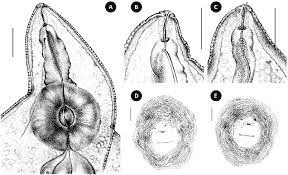
Introduction
M. luci was first described in 2014 from different plant species in Brazil, Chile and Iran. In the EPPO region, M. luci (initially identified as ‘M. ethiopica’) was first found in 2003 on glasshouse tomatoes in 1 location (Dornberk) in Slovenia. All infested plants were destroyed and the nematode was no longer found. However in 2015, M. luci was found again on tomato roots in a glasshouse near Ljubljana (village of Šmartno) where eradication measures are ongoing. In 2009, M. luci (as ‘M. ethiopica’) was detected in 2 soil samples which had been collected from maize (Zea mays) and kiwifruit (Actinidia deliciosa) near Kavalla, Northern Greece. The situation of this nematode in Greece needs to be further investigated. In 2009, M. luci (as ‘M. ethiopica’) was also detected in Turkey in 2 tomato greenhouses of the University of Ondokuz Mayıs and in several commercial cucumber greenhouses in Çarşamba district (Samsun province). In 2013, M. luci was found in a single plot on potato (Solanum tuberosum) in Portugal. In the literature, there is a record of this nematode in Italy but data is lacking on its current situation.
EPPO region: Italy, Greece, Portugal (mainland and Azores at low prevalence), Slovenia (under eradication), Turkey.
South America: Brazil (Distrito Federal, Rio Grande do Sul, Parana), Chile, Guatemala.
Asia: Iran.
Hosts
M. luci has been found on the following plant species: Abelmoschus esculentus (okra), Actinidia deliciosa (kiwifruit), Antirrhinum majus (snapdragon), Brassica oleracea var. italica (broccoli), Cucumis sativus (cucumber), Daucus carota (carrot), Glycine max (soybean), Hylotelephium spectabile (sedum), Lactuca sativa (lettuce), Lavandula angustifolia (lavender), Phaseolus vulgaris (common bean), Polymnia sonchifolia (yakon), Rosa sp. (rose), Solanum lycopersicum (tomato), Solanum tuberosum (potato), Vitis vinifera (grapevine). At least on bean, tomato, and soybean crops, symptoms of decline and stunting, as well as root galling have been reported.
Host range experiments have also showed that M. luci (as ‘M. ethiopica’) can also multiply on a large number of cultivated plants of economic importance, for example: Allium cepa (onion), Apium graveolens (celery), Fagopyrum esculentum (buckwheat), Helianthus annuus (sunflower), Hordeum vulgare (barley), Medicago sativa (lucerne), Oryza sativa (rice), Pisum sativum (pea), Prunus persica (peach), Solanum melongena (aubergine), Spinacia oleracea (spinach), Zea mays (maize).
Damage
As is the case with other root-knot nematodes, both M. ethiopica and M. luci damage plants by affecting the development of their root systems which are distorted by multiple small and large galls and devoid of fine roots. Affected plants can also show above ground symptoms such as stunting and wilting. In Brazil and Chile, M. ethiopica is considered to be a damaging species on kiwi and grapevine, as infestations lead to a reduction of plant growth, fruit size and quality. In Brazil, it has also been reported to cause multiple galls on potato root systems, as well as protuberances on tubers. Data is generally lacking on the extent of damage and the economic impact these nematodes may cause on their different host plants. Data is also lacking on their biology.
Transmission
As a root-knot nematode species, both M. ethiopica and M. luci can easily be transmitted with soil and plant root material. In Chile, it is suspected that movements of contaminated grapevine nursery stock have probably resulted in serious infestations in various vineyards. In Brazil, it is also suggested that M. ethiopica was introduced in 1989 to Rio Grande do Sul on kiwi seedlings imported from Curicó (Chile), and that the pest was then moved to Distrito Federal on infested bulbs of Polymnia sonchifolia (yacón or Peruvian ground apple) from Rio Grande do Sul.
Pathways
Infested soil and growing media, plants for planting, bulbs and tubers from countries where M. ethiopica or M. luci occur are the most probable pathways to introduce and spread these pests into the EPPO region. Soil attached to machinery, tools, footwear, or plant products is also another possible pathway.
